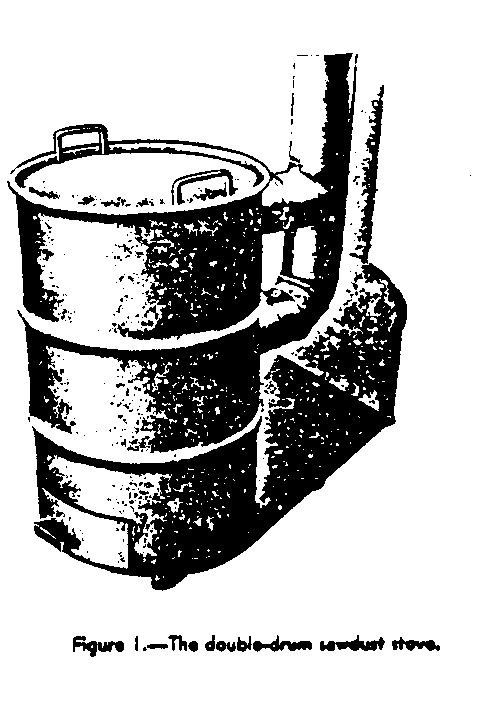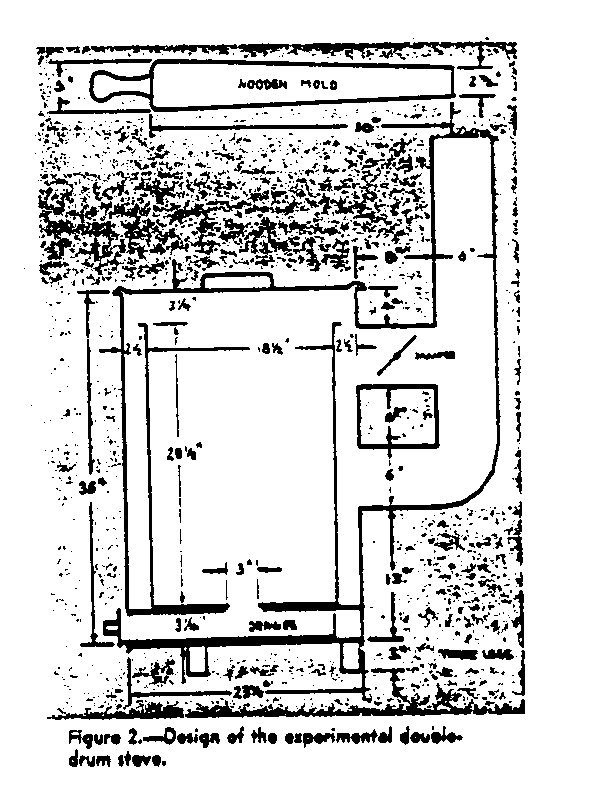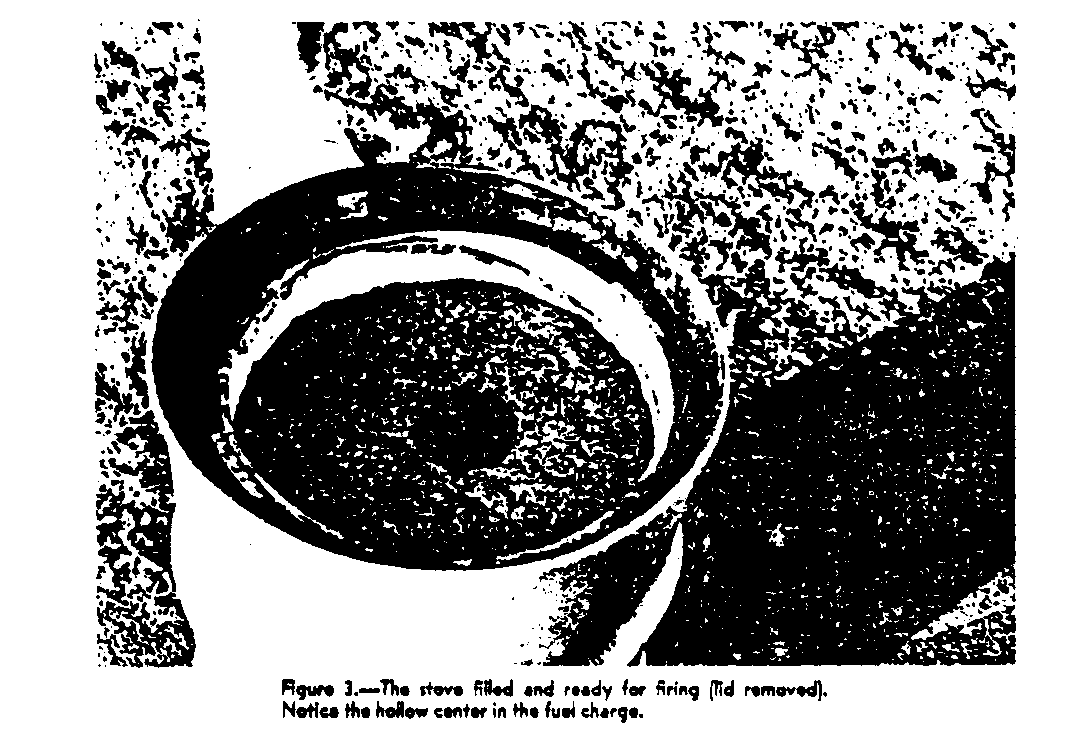This bulletin describes an inexpensive home-made stove for burning loose sawdust. Constructed from empty oil drums, the stove can heat a room 20 feet square for 6 to 8 hours without tending.
Jeffrey Wartluft is a VITA Volunteer who is a forest products technologist with the United States Forest Service. While working on the design for the sawdust stove, he researched old VITA plans from Afghanistan and compared them with stoves he had seen while in Chile as a Peace Corps Volunteer. The result has been published as Forest Service Research Note NE-208, 1975, from which this bulletin was taken.
Please send testing results, comments, suggestions and requests for further information to:
Technical Bulletins VITA Publications Service 1600 Wilson Boulevard, Suite 500 Arlington, VA 22209 USA
ISBN 0-86619-109-7
Volunteers In Technical Assistance 1600 Wilson Boulevard, Suite 500 Arlington, VA 22209, USA
VITA TECHNICAL BULLETINS
This Technical Bulletin is one of a series of publications that offer do-it-yourself technology information on a wide variety of subjects.
Technical Bulletins are idea generators, intended not so much to provide a definitive answer as to guide the user's thinking and planning. Premises are sound and testing results are provided, if available.
Users of the information are asked to send us their evaluations and comments based on their experiences. Results are incorporated into subsequent editions, thus providing additional guidelines for adaptation and use in a greater variety of conditions.
In the United States, sawdust traditionally has been burned in large furnaces for industrial heating, in smaller furnaces for home heating, and in fireplaces in the form of compressed logs. In other parts of the world, loose sawdust has been burned for years in inexpensive double-drum stoves. These stoves are well suited for heating cabins or workshop areas.
The double-drum sawdust stove has other advantages. It is inexpensive to fabricate; it uses recycled components; it burns inexpensive fuel; and it heats a long time with minimum tending.
After seeing these stoves heating homes in Chile and reviewing plans(1) for the types used in Afghanistan and England, I fabricated an experimental stove (Figure 1) at the Forest Products Marketing Laboratory in Princeton, West

Virginia. Then I learned how to use the stove by firing it with several kinds of fuel having different moisture contents.
(1) Wood Waste as a Fuel, Forest Products Research Lab. Research Leaflet 41. Princes Risborough, England. 11 pp. 1956.
Fabrication
The experimental double-drum stove was made from a 55-gallon steel drum and a 30-gallon drum, plus about $25 worth of other materials, including stovepipe. Tools needed for fabrication are tin snips, hammer and anvil, rivet tool, drill and bit, metal-cutting saber saw, and equipment for brazing with bronze.
The stove (Figure 2) consists of two drums, one inside the other. A false

floor inside the outer barrel supports the inner barrel. A drawer opening below the false floor provides draft, and the drawer catches dropping ashes, which are then easily removed. Three-inch holes in the center of the false floor and the inner barrel bottom let air pass up to the fuel and let ashes fall into the drawer.
A tightly fitting lid covers the outer barrel. Under this lid are about 3 inches of clearance to the top of the inner barrel. Two 6-inch diameter stovepipes exit from the outer barrel, allowing smoke to exhaust. The outer barrel is supported by three legs to keep excess heat from the floor and prevent rocking.
The false floor and drawer were fashioned from 20-gage sheet metal. Drawer tabs and curved front were fastened with rivets. The false floor rests on two parallel 1/2-inch steel rods, which were run through holes on opposite sides of the outer barrel, and were brazed to it.
Two handles of the lid and one on the drawer were made of 1/2-inch steel rod, bent to shape, and attached by brazing.
The two joints of stovepipe were brazed to the outer barrel, one near the top of the stove and the other directly beneath it. These two horizontal pipes join into a common vertical pipe. The upper horizontal pipe is fitted with a damper. The vertical pipe is fitted with elbows, straight lengths, wall or ceiling thimble, and a vent cap to suit the individual installation.
Smaller or larger stoves can be fabricated with heavy-gage sheet metal (about 14 gage). The relative sizes of the components should be roughly proportional to the dimensions of our experimental stove.
Installation
The stove should be placed at least 24 inches away from any combustible wall or floor material.(2) It should be set on a fireproof floor pad that extends at least 18 inches in front of the drawer opening. A wall thimble or triple wall pipe should be used where the pipe goes through the wall or ceiling and roof. The flue pipe should not have long horizontal sections, as they favor condensation of flue gas. The condensates leak at the joints and cause pipe corrosion.
(2) Using Coal and Wood Stoves Safely. National Fire Protection Association NFPA HS-8. 12 p. Boston. 1974.
Fuels
In addition to sawdust, bark residue from sawmills and planer shavings from planing mills can be burned in the stove. The limiting factor for fuels is their moisture content. Though fuel having more than 100 percent moisture content (oven-dry basis)(3) will burn, most of the heat is used in evaporating fuel moisture. Fuel below 60 percent moisture contents works well. Fresh sawdust, shavings, and bark typically have moisture contents ranging from 50 to 110 percent. The best source of fuel is sawdust or shavings from dried lumber.
(3) The water in the material weighs as much as the dry material itself.
Fuel can be stored in a bin or in plastic garbage bags. If a bin is used, the inner barrel is either removed and taken to the bin for filling, or a large bucket is used to transfer the fuel from bin to stove.
How to Use the Stove
A round wooden mold, 3 feet long, tapering from 5 inches to 2 7/8 inches, is used to shape the fuel charge.
To fill the stove, place the small end of the wooden mold in the hole at the bottom of the inner barrel. Then tamp sawdust or bark around it until the inner barrel is full. Wet fuel should not be tamped as much as dry fuel. Carefully remove the mold, leaving a vertical hole in the center of the fuel charge (Figure 3).

Before lighting the fire, open the drawer and damper. Then crumple waste paper, drop it down the hole in the fuel, and place the lid on the outer barrel. Place additional crumpled paper in the drawer and light it; move the drawer in so the flames will ignite the paper in the hole.
Once the fuel is burning, adjust the drawer and damper to obtain the desirable rate of burning and output of heat. Closing the damper forces hot air to circulate lower in the stove before leaving through the bottom stovepipe. Thus more heat is transferred to the room and less is lost through the pipe.
CAUTION: Do not open the lid while the fuel is burning. Oxygen thus mixed with flammable gases can cause a flare-up.
With dry sawdust and a good draft, one charge of this stove can heat a room 20 feet square for 6 to 8 hours with no tending. Wetter fuel heats less but lasts longer. During the first 2 hours of burning, there is enough heat at the center of the lid to boil water or cook with. As burning progresses, the heat on the lid is distributed more toward the rim.
VITA VOLUNTEERS IN TECHNICAL ASSISTANCE
ABOUT VITA
Volunteers in Technical Assistance (VITA) is a private, nonprofit, international development organization. Started in 1959 by a group of concerned scientists and engineers, VITA maintains an extensive documentation center and worldwide roster of volunteer technical experts. VITA makes available to individuals and groups in developing countries a variety of information and technical resources aimed at fostering self-sufficiency--needs assessment and program development support; by-mail and on-site consulting services; information systems training. It also publishes a quarterly newsletter and a variety of technical manuals and bulletins.
For more information, contact: VITA 1600 Wilson Boulevard, Suite 500 Arlington, VA 22209 USA